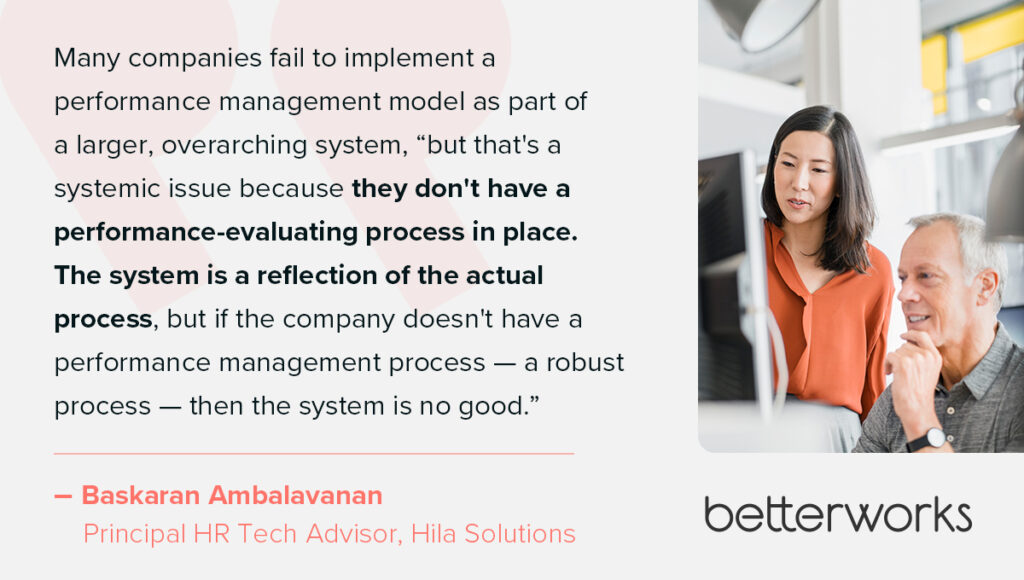Performance management technology has traditionally been rolled up into larger human capital management solutions — and those tend to be underutilized. That’s because the most critical performance management questions are really questions about your processes, says Baskaran Ambalavanan, principal HR tech advisor at Hila Solutions.
Many companies fail to implement a performance management model as part of a larger, overarching system, “but that’s a systemic issue because they don’t have a performance-evaluating process in place,” Baskaran says. “The system is a reflection of the actual process, but if the company doesn’t have a performance management process — a robust process — then the system is no good.”
Some employers are realizing they need a formal, ongoing approach to performance management — and tech solutions to support this shift. But for other employers, it’s the existing tech solutions that aren’t delivering what’s needed to drive better performance.
Baskaran shares three non-negotiable elements of a dedicated performance management platform.

Focus on functionality and ease of use
The first and most important criterion is functionality. Every HR system offers some type of performance management module, Baskaran says. If you’re going to break performance management off into a standalone system, it has to offer something more than the standard system offers, such as 360-degree feedback, or the flexibility to obtain seamless multi-rater feedback from cross-functional teams, leaders, and co-workers. A standalone system should also support communication between teams and supervisors, encourage continuous feedback, and track individual and team OKRs.
“Most employers prefer to have everything in one place,” Baskaran says. “They don’t like to have disparate systems — unless there is a value to it.” As part of your research, ask vendors to explain what their product does that larger solutions can’t offer.
However, functionality won’t matter if the platform isn’t easy to use. Look for a simple, user-friendly interface that allows you to easily maximize the point solution’s potential. Consider what additional services vendors offer, such as consultations and ongoing support as you develop a continuous performance process.
Look for smooth data integration
HRIT leaders examining point solutions want to know whether a standalone system integrates with their organization’s larger HR information system. “Even with a client that wants to have one system, they’re open to go with a standalone system as long as there’s an integration with it,” Baskaran says.
You probably don’t need a solution that provides a minute-to-minute — or even a day-to-day — data transfer, but “the integration is absolutely needed at some level,” Baskaran continues. “That’s one of the issues that will come up as a fundamental question.”
Point solutions need to interact with the base code so they can work over all the data and information you need. For example, you need your point solution system to account for staffing changes, such as promotions, leaves of absence, or changes in skills and qualifications.
This doesn’t have to be complicated, however, as most vendors understand integration’s importance. “Integration can be made easy,” Baskaran says. “It depends on the product configuration.”
In addition to integrating existing HRIS applications, the point solution should be able to integrate seamlessly with collaborative tools, like Slack and Google Workspace, and have an accessible API to support custom integrations as well.
Maintain high security standards
When reviewing cloud-based performance management solutions, prioritize systems with a strong data protection program in place.
A trend in performance management is collecting feedback from multiple sources, for example. Employees view this as a fairer approach than feedback from managers alone, according to our 2023 State of Performance Enablement report. Although multiple sources of feedback produce fairer output, this approach can complicate data security. Baskaran suggests asking a few pertinent questions: “Who gets access, and what level of access do they get? What can they view? How is the data protected?”
By asking these questions before choosing a vendor, you can identify point solutions that meet your overall needs and possess the necessary functionality, integration, and security.
“Many companies have the desire to change the way they do performance management, but they don’t have the know-how,” Baskaran says. Look for a vendor with a high-quality product and the ability to develop that “know-how” in-house — they can deliver value that an all-in-one solution simply can’t match.
Want to learn more? Discover what employees really want from performance management technology.
Do you have the right performance management technology?





